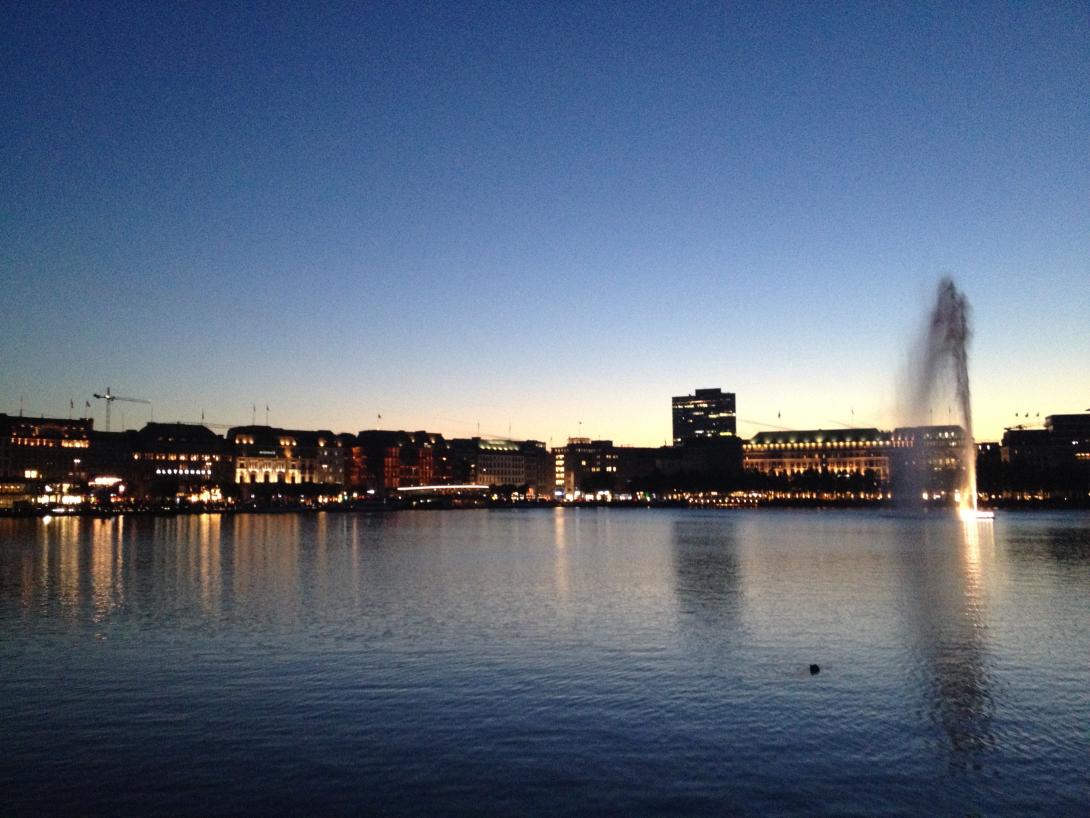Michael Lotinga – October 2016
The 45th International Congress and Exposition of Noise Control Engineering landed with a splash in the civilised surroundings of Hamburg, along with around 1,500 acousticians from over 60 different countries.
Set over 4 days, with corresponding satellite events in Berlin, the German Acoustical Society had selected a venue next door to the famous Planten un Blomen park, which provided a very welcome air of peace and calm to balance the sometimes hectic goings-on at the congress centre. At my first international conference, I was slightly unprepared for how relentless the program would be: 15 minute slots for every presenter, with 3 minutes for questions, and 2 further minutes to allow attendees to slip in and out of each room; over 15 rooms spread around 3 floors, with simultaneous talks taking place at virtually all times, starting at 8am every day, with final talks ending by 6pm – not a program for the faint-hearted or unfit! The conference was opened appropriately enough using the analogy of cross-country ski touring; Prof. Otto von Estorff greeted us by comparing the painstaking work and preparation many delegates had undergone to the long climb to the top of a mountain – the opening ceremony signalled the moment that everyone could now launch their skis and speed down the sides!
The first plenary lecture, entitled ‘The Noise in Our Head’, discussed the emotional and psychosocial aspects of noise, how it affects us and how we react to it. Afterwards there was time to mingle and soak up the buzz of the opening day, or venture out into Hamburg to explore the city. The centre of Hamburg, around the Old City, is set at the foot of two man-made lakes connecting the Alster and Elbe rivers via narrow canals. There are lots of park areas around the edges, providing wonderful vantage points to watch the boats and the jet fountain (which will look very familiar to visitors of Geneva), and see the sun setting over the flying saucer TV tower (the Heinrich-Hertz-Turm, aptly named after the physicist namesake of the unit of wave cycles-per-second), poking out of the skyline.
My first day of talks proper was a success; my critical tip for others at their first major conference is to very carefully prepare your own schedule in advance – you really do need to plan your movements; this is not a music festival, where floating from one act to another can result in memorable chance discoveries! With so little time on the clock you will kick yourself for missing bits, and, like music festivals, there will be the inevitable clashes and tricky decisions to make! With mobile ‘app’ tools now available to personalise your own planner, there is no excuse.
The sheer variety of content at this kind of broad event is also staggering: the first day alone had dedicated sessions on psychoacoustics, aircraft noise, railway vibration, building acoustics, soundscapes, the new WHO European guidelines, active noise control, acoustic black holes, and a 20-year memorial session for the esteemed Manfred Heckl (co-author of the seminal Structure-borne Sound).
The second day I spent trying to control my jitters while listening to talks on noise respite schemes at Frankfurt Airport, and active noise control for open windows, knowing that very soon it would be my turn to be eyeballed by an expert audience, while trying to explain our human response research review paper on wind turbine noise amplitude modulation. When the time came, it was far less painful than I expected, and the many hours spent preparing the talk overcame the stress of presenting it to a public gallery. Post-conference drinks for young acousticians and researchers at the hotel bar next door helped to wash away the tension!
The final day yielded more interesting wind farm noise material, discussions of the NORAH project, and a gobsmacking final plenary from Dr. Marc Schöneweisner, who described advances in using MRI scans to decode signals in the auditory cortex, leading us on to the reverse application of neural networks used for machine learning leading to artificial imagination, and even a potentially dark future of mind and dream-reading machines…!
After all this I needed some diversion, and found respite of my own in the company of new-found conference acquaintances, taking in the sounds at the Cascadas bar with the Jazz Federation of Hamburg – a brilliant way to calm the nerves after an intense four days.
Memorable highlights from the conference also included the paper on using modal analysis to determine the ripeness of fruit, in which the authors offered around their experimental test subjects for consumption by a hungry audience, and the poster presentation from a group investigating cultural differences in the perception of car engine sounds – suffice it to say Italians and Germans have very different tastes in linearity and harmonic content!
I was sorry to leave Hamburg, though in truth the intensity of the conference programme had meant opportunities to explore were fleeting. Inter-noise 2016 was a great event; an incredible opportunity to interact and share knowledge with the international acoustics community and generate the sparks of new ideas. I can’t wait for the next one!
I am grateful for the funding provided to attend Inter-noise by my company WSP | Parsons Brinckerhoff.
The full Proceedings of Inter-noise 2016 are available online: http://www.internoise2016.org/
Comments or questions relating to this article can be entered below (logged in members), or emailed to michael.lotinga pbworld.com
pbworld.com
